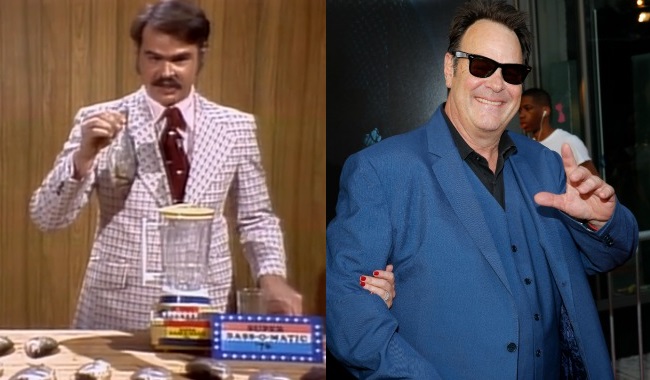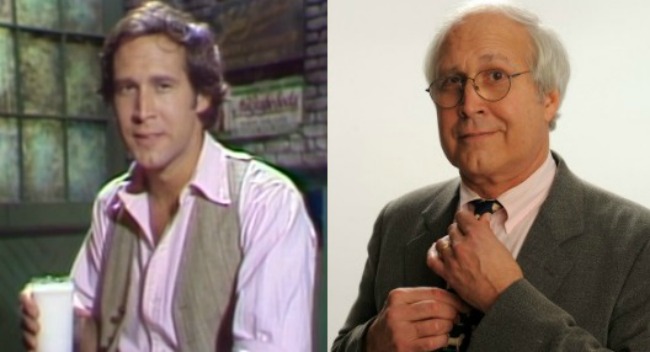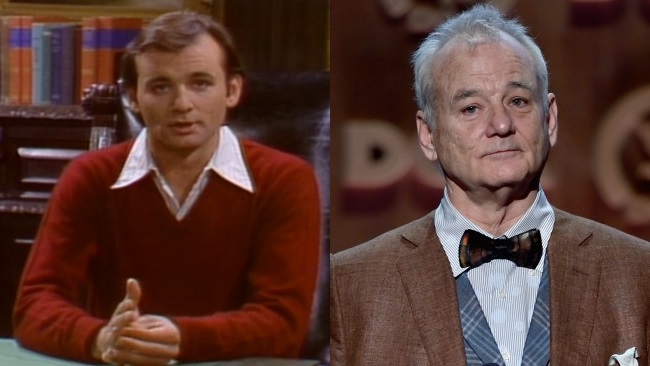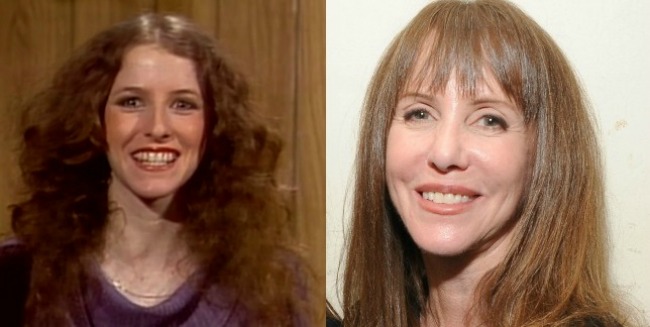On Sunday, Saturday Night Live will celebrate its 40th anniversary with an epic special that will welcome back several of the show’s most beloved former stars. In attendance will be many of the people who were there when it all started, and others who kept it going long past when the experts said it had outlived its usefulness.
There are just 141 people who have been cast members on Saturday Night Live. Some of them are still stars and others have faded into obscurity, but all had the chance to elevate the iconic show and be elevated by it. Below is a look at the people who were there during the first decade and what they’ve been up to since they left:
Dan Aykroyd (1975-1979)

One of SNL‘s first stars, Aykroyd would depart the show in 1979 en-route to a strong film career with standouts like Trading Places, The Blues Brothers, Ghostbusters, and an Academy Award nomination for his role in Driving Miss Daisy.
Aykroyd has been limited to supporting and cameo roles since the late ’90s following a series of busts including Blues Brothers 2000, but in that time, he’s remained steadfast in his effort to sell people vodka out of a crystal skull. He’s also kept the Ghostbusters flame alive while Bill Murray and Ivan Reitman have given up on it and Harold Ramis has passed away, so hopefully he’s gonna get PAID now that Paul Feig has taken the baton.
Peter Aykroyd (1979-1980)
The exit of Dan Aykroyd and John Belushi in 1979 sparked a then-unparalleled influx of fresh blood into Saturday Night Live, and Peter Aykroyd (brother of Dan) was part of the new batch of talent. He never really made his mark on the show in his time as a cast member and writer. Unfortunately, the same can also be said of a post-SNL career that includes a handful of appearances in Dan Aykroyd movies, a co-writer credit on Nothing But Trouble and a Canadian show called PSI Factor: Chronicles of the Paranormal.
Peter Aykroyd has been un-busy since the turn-of-the-century as far as Hollywood is concerned.
John Belushi (1975-1979)
Chevy Chase was Saturday Night Live‘s first star, but Belushi became its first enduring icon by virtue of his comet-like life and tragic death — the first of many that the show has experienced in its 40 years.
It’s hard to think about Belushi and not imagine what he could have become had he been able to master his demons. With his legendary SNL run, The Blues Brothers, Animal House, and a dominant performance in the underwhelming 1941 in the rearview and potentially Ghostbusters on the horizon, things looked limitless for Belushi before it all came crashing down.
Chevy Chase (1975-1976)

A year older than Lorne Michaels when he was initially hired to be a writer for the show’s first season, Chevy Chase became the face of Saturday Night Live thanks to his pratfalls and his work as the first (and possibly best) anchor of Weekend Update. And then, in an instant, he was gone, chasing love on the west coast and a film career that would include Caddyshack, the Vacation films, Fletch, and a slew of middling ’80s comedies before a creative downfall that was only halted by his work on Community, which is the John-Travolta-in-Pulp–Fiction of comedy rebirths.
Chase is presently set to star in a pilot for ABC beside his Vacation co-star Beverly D’Angelo, and he’ll rightly be on hand to celebrate the 40th anniversary of SNL on Sunday, though that’s a small miracle considering the stories about his backstage fist fight with Bill Murray, his verbal abuse of Terry Sweeney in 1985, and more unfortunate behavior in 1997 that allegedly got him temporarily banned from the show.
George Coe (1975)
For a lot of people, Saturday Night Live is both their first big credit and the most notable thing on their resume, but George Coe came to the show as a 46-year-old Broadway vet with an Academy Award nomination as a short film co-director. And after quickly leaving the show, Coe embarked on a career as a character actor with notable performances in Kramer vs. Kramer, Blind Date, and as the voice of Woodhouse on Archer. He also returned to SNL to play a judge in the William Shatner hosted 1986 episode that’s more well known for Shatner’s “Get a Life!” sketch.
Jane Curtin (1975-1980)
She came off as a bit of an outsider in the SNL oral history of “Live From New York” thanks to her habit of abstaining from the original cast’s partying ways. She also never received the attention that Gilda Radner did, but Jane Curtin had a rock-solid tenure on Saturday Night Live that was punctuated by her work on Weekend Update.
After leaving the show, Curtin continued to keep a somewhat low profile, eventually finding stability and acclaim in Kate and Allie and later on 3rd Rock from the Sun. More recently, Curtin has kept busy with supporting roles in Unforgettable, I Love You Man, and The Librarians.
Tom Davis (1977-1980)
Davis was a featured player and occasional on-screen presence alongside his longtime comedy partner Al Franken (who we’ll look it as a part of the ’80s group), but that work is positively dwarfed by his contribution to Saturday Night Live as a writer from 1975-1980, 1985-1994, and 2002-2003. So many all-night writing sessions, so many tweaks, so much greatness coming out of his pen and his mind. The Continental, Nick the Lounge Singer, and The Coneheads — Tom Davis had a hand in creating those bits and hundreds more. He’d probably be in the writer’s room for the weeks leading up to the 40th anniversary special if he hadn’t passed away in 2012 from cancer.
Jim Downey (1979-1980)
Jim Downey’s most memorable on-screen work came as Grayson Moorhead and Jonah Hill’s mack-mate decades after his one season as a featured player, but like Davis, his lengthy tenure as a writer on the show is where his true impact has been felt. And lengthy is an understatement. From 1976-1980, 1984-1998, and 2000-2013, Jim Downey held court in the SNL writer’s room, specializing in political humor and serving as head writer from 1986-1995 before taking over Weekend Update writing duties during the Norm Macdonald era.
In addition to his work on SNL, Downey also worked as David Letterman’s head writer from 1982-1984 on Late Night.
Garrett Morris (1975-1980)
A prolific playwright and singer before he became known to the masses as Chico Escuela and the a translator for the deaf on SNL, Garrett Morris’ talents were far from fully explored in five seasons on the show, but he has worked steadily since being dismissed following Lorne Michaels’ exit in 1980.
His roles on The Jamie Foxx Show and 2 Broke Girls have offered the most longevity, but he’ll forever be Chocolate Chip Charlie in The Stuff to me.
Bill Murray (1976-1980)

Murray was in on the original cast auditions but narrowly missed out. When Chevy Chase decided that he was leaving after the first season, though, Murray’s number was called and over the course of his four seasons on the show, he established himself as an SNL legend. Something that has only been enhanced by arguably the most impressive post-SNL career of all thanks to Stripes, Ghostbusters, Groundhog Day, Rushmore, Lost in Translation, and his role as a modern day folk hero.
Laraine Newman (1975-1980)

A founding member of The Groundlings and SNL, Laraine Newman often gets lost in the shuffle when the original SNL cast is discussed because she tried her best to avoid repeating characters, and she doesn’t have an obvious post-show project that one can point to, but she held her own beside otherworldly talent on the show for five years and she’s carved out an impressive voice acting career that is still going strong.
Don Novello (1979-1980, 1985-1986)
You probably know Novello better by the name of his character, Father Guido Sarducci, which he debuted on The Smothers Brothers and ported over to SNL before continuing to play the character on Square Pegs, Blossom, Unhappily Ever After, and The Colbert Report.
Novello also wrote on the show from 1978-1980 and during the 1985-1986 season when Lorne Michaels returned from his lengthy hiatus. He had a supporting role in The Godfather III and in Gilda Live!
Michael O’Donoghue (1975)
Michael O’Donoghue was as much a renaissance man as he was a firestarter in his two-terms as head writer, chasing off Catherine O’Hara before she had a chance to appear in an episode and getting fired some time after he had written a 20-minute sketch comparing NBC President Fred Silverman to Hitler.
Prior to these lowlights (or highlights, depending on your view of inter-office rebellion), O’Donoghue served as SNL‘s first head writer and was the first person to appear on-screen on the show. He also co-wrote Scrooged, penned country music songs, was a huge part of National Lampoon’s radio and print successes in the early ’70s, wrote a graphic novel called Phoebe Zeit-Geist, and wrote the bizarre and fantastic Mr. Mike’s Mondo Video, which means he founded The Mainland Temple of the Perfect Wave and did more to turn Jack Lord into a God than any hair styling product ever could.
Michael O’Donoghue died in 1994 of a cerebral hemorrhage.
Gilda Radner (1975-1980)
We’ve gone through the show’s first star (Chase), it’s first icon (Belushi), and the biggest post-show star (Murray), but Gilda Radner had them all beat because she was probably the most talented person in the cast. And Radner is still the gold standard thanks to her ability to be silly, serious, or wild while drawing people’s eyes to her, inhabiting a character and making the audience (and members of the cast and crew) fall in love with her. Unfortunately, Radner never really found another role that fit her as well as the myriad of ones that she got to play at SNL before she died in 1989 from cancer.
Tom Schiller (1979-1980)
Schiller was another writer-turned-featured-player. A staffer on the show from 1975-1980, and then again from 1988-1990, Schiller’s biggest contribution to the show was as the short filmmaker behind “Don’t Look Back in Anger” and “Love is a Dream.” Post-SNL, he wrote and directed the incredibly weird Nothing Lasts Forever and has gone on to direct numerous commercials.
Paul Shaffer (1979-1980)
Shaffer went from being a member of the band (and an occasional bit player) to full-fledged feature player status in 1979. Following his exit from SNL (along with almost everybody else) in 1980, Shaffer eventually made his way to David Letterman’s side on Late Night and now The Late Show. Where he’ll go once Letterman retires is anyone’s guess, but I imagine penning a sequel to “It’s Raining Men” isn’t out of the realm of possibility.
Alan Zweibel (1979-1980)
Zweibel wrote on the show from 1975-1980 and did some time with Lorne Michaels on The New Show (the short-lived sketch series that Michaels created during his SNL sabbatical) before transitioning to sitcoms and It’s Garry Shandling’s Show, which he co-created. He also wrote North and Dragnet, but I won’t hold that against him.
Zweibel has also written several books and he recently contributed material to Billy Crystal’s 700 Sundays.






